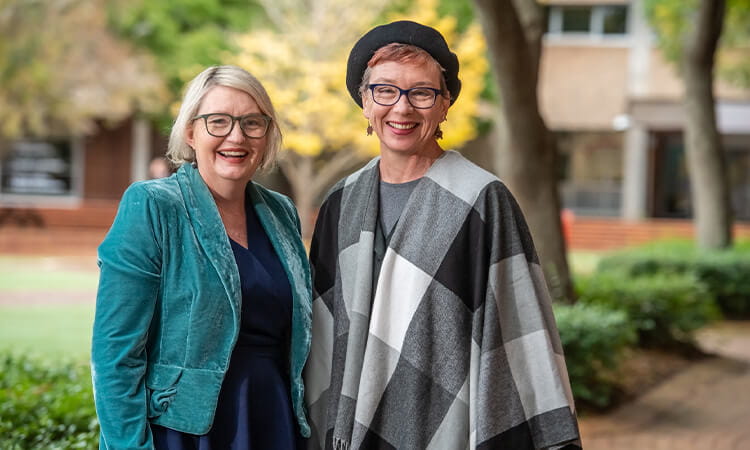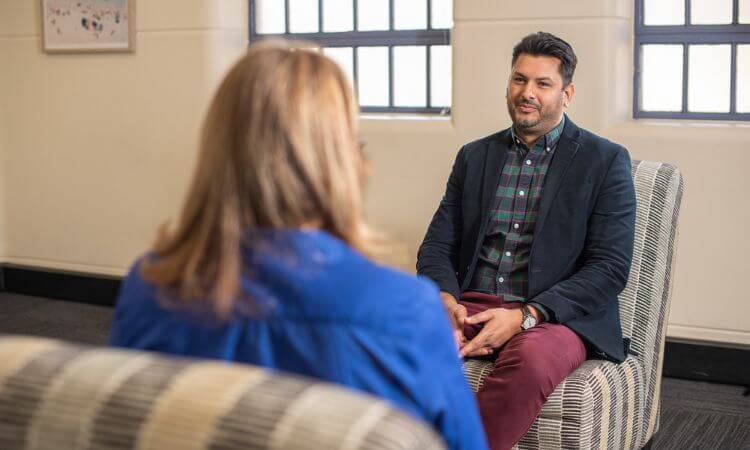The therapeutic value of pets, particularly dogs, is increasingly recognised and has been highlighted in a recent University of Southern Queensland study.
Furry faculty member Bella was a much-loved black Labrador who died in January, aged 14. She was a trained and accredited therapy dog, and brought joy to clients, staff and students at the University of Southern Queensland Sport and Exercise Clinic at Ipswich.
Bella was also the focus of a new research study, which explored for the first time the inclusion of a dog in an exercise physiology service and ways animal-assisted therapy could enhance the practice.
The study was published in the journal Animals.
Bella worked for up to eight hours per week in the clinic where exercise physiology students worked with predominantly older adult clients with chronic, complex health conditions.
She often went on group walks, participated enthusiastically in mobility activities and accompanied distressed clients through difficult moments.
Bella’s accredited exercise physiologist handler and lead researcher Associate Professor Lainie Cameron said she made a positive impact.
“Most of the clients and students we surveyed responded positively to having a therapy dog in the service,” she said.
“Some participants even told us they looked forward to their exercise sessions because they knew Bella would be there.
“However, most of those surveyed overlooked the substantive clinical potential of animal-assisted therapy – pain reduction and exercise adherence – in favour of the comfort and enjoyment of having a dog in the clinic.
“Overall, our conclusion was a therapy dog may enhance some aspects of exercise physiology service delivery, including serving as a social catalyst.”
Dr Samantha Brown, a lecturer in psychology at the University of Southern Queensland, was a co-author of the study.
She knows firsthand the benefit of therapy dogs as she has her own, Audrey, who comes to the Ipswich campus with her to support student and staff well-being.
Dr Brown said there was growing evidence that therapy dogs in healthcare settings can reduce anxiety, heart rate and blood pressure and improve well-being.
“The use of dogs in therapy was once considered a fringe therapy, but it is gaining popularity with health practitioners and the wider community as an innovative way to improve mental and physical health,” she said.
“We are now seeing the use of dogs as a well-being strategy in various settings such as hospitals, schools, and even the court system.
“The healing power of dogs is breaking down barriers to accessing and engaging in mental and physical healthcare, particularly for more vulnerable clients like children and older adults.”
Associate Professor Cameron said the next stage of their research would investigate how well animal-assisted therapy worked as an exercise motivator, increasing accessibility for people unfamiliar with exercise and reducing dropout rates from ongoing training.
She was convinced dogs were the paw-fect exercise partners.
“‘Get a dog’ is often suggested to motivate older adults to undertake regular exercise,” Associate Professor Cameron said.
“Simply owning a dog won’t help you overcome health conditions, but the more strongly bonded with a dog, the more likely you are to walk that dog, and the more the dog influences your exercise behaviour.
“Many of the clients told us they appreciated being able to share ‘ownership’ of Bella through the clinic.
“Having many things in common made them even closer.
“Bella was 10 years old, a senior dog when she first attended the university clinic. She had some osteoarthritis in the large joints of her hind limbs, limiting her capacity for rapid movement.
“She also had a history of fearful behaviour when first rehomed. A story often shared with the older clients who lacked confidence in their ability to commence a new exercise.
“Perhaps it is possible to teach an old dog new tricks and to teach a little old lady to pump iron.”



